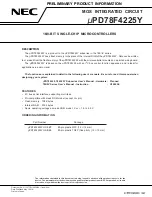
15.7.15.1 Receive Frame-Synchronization Modes
shows how you can select various sources to provide the receive frame-synchronization signal and
the effect on the FSR pin. The polarity of the signal on the FSR pin is determined by the FSRP bit.
In digital loopback mode (DLB = 1), the transmit frame-synchronization signal is used as the receive frame-
synchronization signal.
Also in the clock stop mode, the internal receive clock signal (MCLKR) and the internal receive frame-
synchronization signal (FSR) are internally connected to their transmit counterparts, CLKX and FSX.
Table 15-37. Select Sources to Provide the Receive Frame-Synchronization Signal and the Effect on the
FSR Pin
DLB
FSRM
GSYNC
Source of Receive Frame
Synchronization
FSR Pin Status
0
0
0 or 1
An external frame-synchronization signal
enters the McBSP through the FSR pin. The
signal is then inverted as determined by
FSRP before being used as internal FSR.
Input
0
1
0
Internal FSR is driven by the sample
rate generator frame-synchronization signal
(FSG).
Output. FSG is inverted as determined by
FSRP before being driven out on the FSR
pin.
0
1
1
Internal FSR is driven by the sample
rate generator frame-synchronization signal
(FSG).
Input. The external frame-synchronization
input on the FSR pin is used to synchronize
CLKG and generate FSG pulses.
1
0
0
Internal FSX drives internal FSR.
High impedance
1
0 or 1
1
Internal FSX drives internal FSR.
Input. If the sample rate generator is
running, external FSR is used to synchronize
CLKG and generate FSG pulses.
1
1
0
Internal FSX drives internal FSR.
Output. Receive (same as transmit) frame
synchronization is inverted as determined by
FSRP before being driven out on the FSR
pin.
Multichannel Buffered Serial Port (McBSP)
SPRUH18I – JANUARY 2011 – REVISED JUNE 2022
TMS320x2806x Microcontrollers
931
Copyright © 2022 Texas Instruments Incorporated
Содержание TMS320 2806 Series
Страница 2: ......
















































